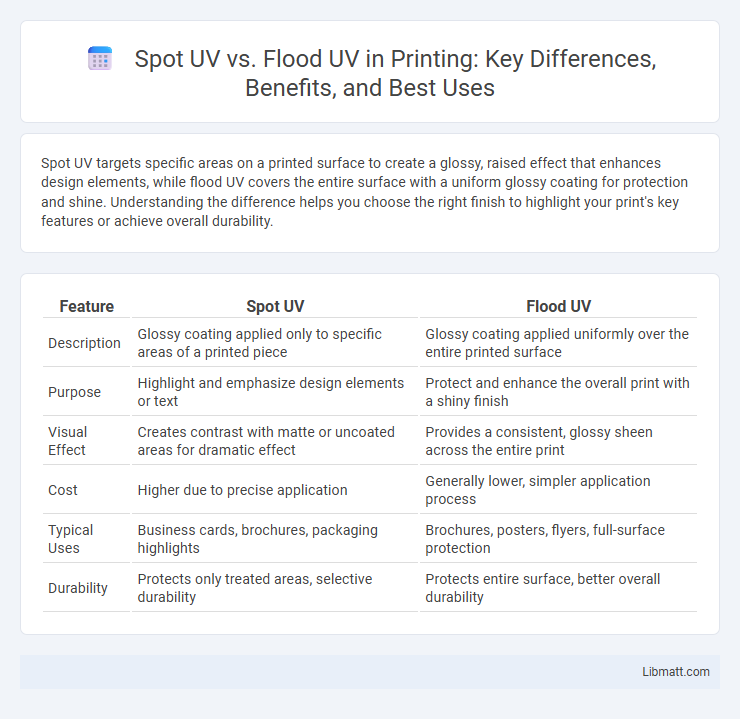Spot UV targets specific areas on a printed surface to create a glossy, raised effect that enhances design elements, while flood UV covers the entire surface with a uniform glossy coating for protection and shine. Understanding the difference helps you choose the right finish to highlight your print's key features or achieve overall durability.
Table of Comparison
| Feature | Spot UV | Flood UV |
|---|---|---|
| Description | Glossy coating applied only to specific areas of a printed piece | Glossy coating applied uniformly over the entire printed surface |
| Purpose | Highlight and emphasize design elements or text | Protect and enhance the overall print with a shiny finish |
| Visual Effect | Creates contrast with matte or uncoated areas for dramatic effect | Provides a consistent, glossy sheen across the entire print |
| Cost | Higher due to precise application | Generally lower, simpler application process |
| Typical Uses | Business cards, brochures, packaging highlights | Brochures, posters, flyers, full-surface protection |
| Durability | Protects only treated areas, selective durability | Protects entire surface, better overall durability |
Understanding Spot UV and Flood UV
Spot UV coating targets specific areas of a printed surface, creating high-gloss accents that enhance texture and contrast, ideal for highlighting logos or design elements. Flood UV applies a uniform gloss coating across the entire surface, providing overall shine and protection, perfect for packaging or full-cover prints. Both techniques use ultraviolet light to cure the coating quickly, improving durability and visual impact.
Key Differences Between Spot UV and Flood UV
Spot UV targets specific areas of a printed design with a high-gloss finish, enhancing details like logos and text for a striking contrast against matte or uncoated surfaces. Flood UV covers the entire surface uniformly, providing a consistent glossy or matte finish that protects the print and enhances durability. The key difference lies in application precision: Spot UV is used for highlighting, while Flood UV offers overall surface protection and shine.
Advantages of Spot UV Coating
Spot UV coating offers precise gloss and texture contrast by highlighting specific design elements on a printed surface, enhancing visual appeal and tactile interest. This targeted application improves durability by protecting key areas from wear and tear, ensuring long-lasting print quality. Your marketing materials benefit from a premium, professional look that captures attention and elevates brand perception.
Benefits of Flood UV Coating
Flood UV coating provides a smooth, glossy finish that enhances the durability and resistance of printed materials against scratches, moisture, and fading. It offers full-surface protection, making your marketing materials, packaging, and business cards more visually appealing and longer-lasting. Flood UV is cost-effective for large print runs, ensuring consistent quality and vibrant color depth across the entire design.
Best Applications for Spot UV
Spot UV is ideal for highlighting specific design elements such as logos, text, or images, creating a striking contrast against a matte or uncoated background. Its precision application makes it perfect for business cards, invitations, packaging, and promotional materials where you want to draw attention to particular areas. Your printed piece will benefit from enhanced texture and visual appeal, making Spot UV the best choice for emphasizing key details.
Ideal Uses for Flood UV
Flood UV is ideal for large surface areas requiring a consistent glossy finish, enhancing visual appeal on business cards, packaging, and brochures. This coating technique provides a durable layer that protects printed materials from scratches and moisture, extending product longevity. Flood UV works best on wide, flat surfaces where an even, shiny effect is desired without highlighting specific design elements.
Cost Comparison: Spot UV vs Flood UV
Spot UV typically incurs higher costs than flood UV due to its precision application and the detailed finishing it provides on specific areas of a print. Flood UV covers entire surfaces, making it a more cost-effective option for bulk or large-scale projects. Understanding these cost differences helps you choose the best technique based on your budget and the desired visual impact.
Design Considerations for Spot UV and Flood UV
Spot UV enhances specific design elements by applying a glossy, raised coating to targeted areas, creating contrast and tactile interest, ideal for logos, text, or intricate patterns. Flood UV covers entire surfaces with a uniform gloss or matte finish, providing protection and a smooth look while enhancing overall color vibrancy. When choosing between Spot UV and Flood UV, consider factors such as desired visual impact, surface coverage, cost, and the interaction with other design elements to ensure optimal print aesthetics.
Durability and Protection: Spot UV vs Flood UV
Spot UV provides targeted durability by applying a thick, glossy coating only to specific areas, enhancing scratch resistance and visual appeal without covering the entire surface. Flood UV offers uniform protection with a glossy or matte finish, creating a robust barrier against wear, moisture, and UV damage across the whole printed piece. The choice depends on whether selective enhancement or comprehensive surface protection is the priority.
Choosing the Right UV Coating for Your Project
Choosing the right UV coating for your project depends on the desired visual effect and protection level; Spot UV highlights specific areas with a glossy finish, creating contrast and texture, while flood UV covers the entire surface evenly for uniform shine and durability. Your choice should consider the design elements and functionality, as Spot UV enhances brand logos or focal points, whereas flood UV provides robust protection against wear and tear. Evaluate your project's aesthetic goals and usage conditions to select the most suitable UV coating that maximizes both appeal and longevity.
Spot UV vs flood UV Infographic

 libmatt.com
libmatt.com